Natural circulation heating system: common water circuit diagrams
The construction of an autonomous gravity-type heating network is chosen if it is impractical, and sometimes impossible, to install a circulation pump or connect to a centralized power supply.
Such a system is cheaper to install and is completely independent of electricity. However, its performance largely depends on the accuracy of the design.
In order for a heating system with natural circulation to function smoothly, it is necessary to calculate its parameters, correctly install the components and reasonably select the water circuit design. We will help in resolving these issues.
We described the main principles of operation of the gravity system, provided advice on choosing a pipeline, and outlined the rules for assembling the circuit and placing working units. We paid special attention to the design and operation features of one- and two-pipe heating schemes.
The content of the article:
Principles of the natural circulation process
The process of water movement in the heating circuit without the use of a circulation pump occurs due to natural physical laws.
Understanding the nature of these processes will allow competent develop a heating system project for standard and non-standard cases.
Maximum hydrostatic pressure difference
The main physical property of any coolant (water or antifreeze), which facilitates its movement along the circuit during natural circulation, is a decrease in density with increasing temperature.
The density of hot water is less than that of cold water and therefore there is a difference in the hydrostatic pressure of the warm and cold columns of liquid. Cold water, flowing to the heat exchanger, displaces hot water up the pipe.

The heating circuit of a house can be divided into several fragments. Water is directed upward along the “hot” fragments, and downward along the “cold” fragments.The boundaries of the fragments are the upper and lower points of the heating system.
The main task in modeling natural circulation systemswater is to achieve the maximum possible difference between the pressure of the liquid column in the “hot” and “cold” fragments.
A classic element of the water circuit for natural circulation is the acceleration manifold (main riser) - a vertical pipe directed upward from the heat exchanger.
The acceleration manifold must have a maximum temperature, so it is insulated along its entire length. Although, if the height of the collector is not high (as for one-story houses), then insulation may not be carried out, since the water in it will not have time to cool.
Typically, the system is designed in such a way that the top point of the acceleration collector coincides with the top point of the entire circuit. There is an exit to open expansion tank or an air vent valve if using a membrane tank.
Then the length of the “hot” circuit fragment is the minimum possible, which leads to a decrease in heat loss in this area.
It is also desirable that the “hot” part of the circuit is not combined with a long-term section transporting cooled coolant. Ideally, the lowest point of the water circuit coincides with the low point of the heat exchanger placed in the heating device.

The “cold” segment of the water circuit also has its own rules that increase fluid pressure:
- the greater the heat loss in the “cold” section of the heating network, the lower the temperature of the water and the greater its density, therefore the operation of systems with natural circulation is possible only with significant heat transfer;
- the greater the distance from the bottom point of the circuit to the radiator connection, the larger the area of the water column with minimum temperature and maximum density.
To ensure compliance with this last rule, often the furnace or boiler is installed in the lowest point of the house, such as the basement. This placement of the boiler ensures the maximum possible distance between the lower level of the radiators and the point of entry of water into the heat exchanger.
However, the height between the lower and upper points of the water circuit during natural circulation should not be too high (in practice, no more than 10 meters). The furnace or boiler heats only the heat exchanger and the lower part of the acceleration manifold.
If this fragment is insignificant relative to the entire height of the water circuit, then the pressure drop in the “hot” fragment of the circuit will be insignificant and the circulation process will not start.
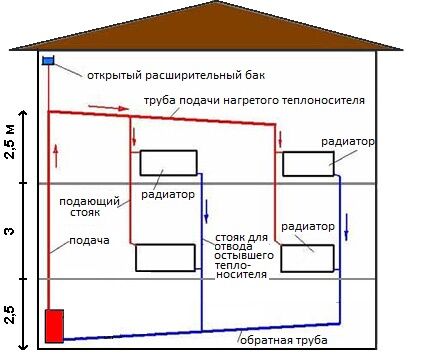
Minimizing resistance to water movement
When designing a system with natural circulation, it is necessary to take into account the speed of movement of the coolant along the circuit.
Firstly, the faster the speed, the faster the heat transfer will occur through the “boiler - heat exchanger - water circuit - heating radiators - room” system.
Secondly, the faster the speed of the liquid through the heat exchanger, the less likely it is to boil, which is especially important for stove heating.
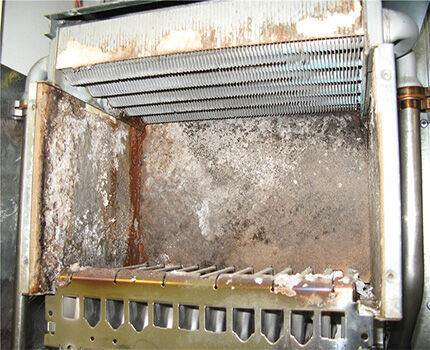
In systems forced circulation heating the speed of water movement mainly depends on the parameters circulation pump.
With water heating with natural circulation, the speed depends on the following factors:
- pressure difference between fragments of the contour at its lower point;
- hydrodynamic resistance heating system.
Methods for ensuring maximum pressure difference were discussed above. The hydrodynamic resistance of a real system cannot be accurately calculated due to the complex mathematical model and the large number of input data, the accuracy of which is difficult to guarantee.
However, there are general rules that, if followed, will reduce the resistance of the heating circuit.
The main reasons for the decrease in the speed of water movement are the resistance of the pipe walls and the presence of narrowings due to the presence of fittings or shut-off valves. At low flow rates, there is virtually no wall resistance.
The exception is long and thin pipes, typical for heating with heated floor. As a rule, separate circuits with forced circulation are allocated for it.
When choosing types of pipes for a natural circulation circuit, you will have to take into account the presence of technical restrictions when installing the system. That's why metal-plastic pipes It is undesirable to use them with natural water circulation because they are connected with fittings with a significantly smaller internal diameter.
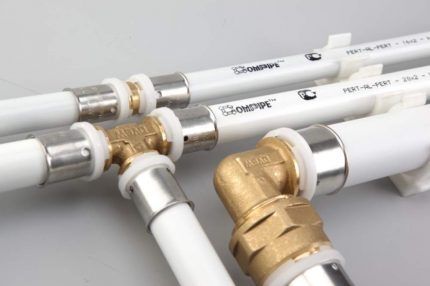
Rules for the selection and installation of pipes
Choice between steel or polypropylene pipes for any circulation occurs according to the criterion of the possibility of their use for hot water, as well as from the standpoint of price, ease of installation and service life.
The supply riser is mounted from a metal pipe, since water of the highest temperature passes through it, and in the case of stove heating or a malfunction of the heat exchanger, steam can pass through.
With natural circulation, it is necessary to use a pipe diameter slightly larger than when using a circulation pump. Typically, for heating rooms up to 200 square meters. m, the diameter of the acceleration manifold and the pipe at the return inlet to the heat exchanger is 2 inches.
This is caused by a lower water velocity compared to the forced circulation option, which leads to the following problems:
- reduction in the amount of heat transferred per unit time from the source to the heated room;
- the appearance of blockages or air pockets, which a little pressure cannot handle.
When using natural circulation with a bottom supply circuit, special attention must be paid to the problem of removing air from the system. It cannot be completely removed from the coolant through the expansion tank, because Boiling water first enters the devices through a line located lower than themselves.
With forced circulation, the water pressure drives air to an air collector installed at the highest point of the system - a device with automatic, manual or semi-automatic control. By using Mayevsky cranes Basically, heat transfer is adjusted.
In gravitational heating networks with a supply located below the devices, Mayevsky taps are used directly for bleeding air.
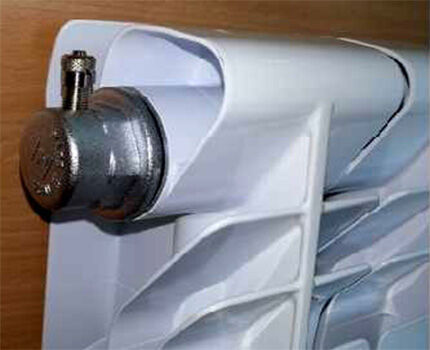
Air can also be removed using air vents installed on each riser or on an overhead line laid parallel to the system mains. Due to the impressive number of air exhaust devices, gravity circuits with bottom wiring are used extremely rarely.
With low pressure, a small air lock can completely stop the heating system. Thus, according to SNiP 41-01-2003, it is not allowed to lay heating system pipelines without a slope at a water speed of less than 0.25 m/s.
With natural circulation such speeds are unattainable. Therefore, in addition to increasing the diameter of the pipes, it is necessary to maintain constant slopes to remove air from the heating system. The slope is designed at the rate of 2-3 mm per 1 meter; in apartment networks, the slope reaches 5 mm per linear meter of the horizontal line.
The supply slope is made in the direction of water movement so that the air moves to the expansion tank or air bleed system located at the top point of the circuit. Although it is possible to make a counter-slope, in this case it is necessary to additionally install vent valve.
The slope of the return line is usually made in the direction of movement of the chilled water. Then the lowest point of the circuit will coincide with the entrance of the return pipe to the heat generator.
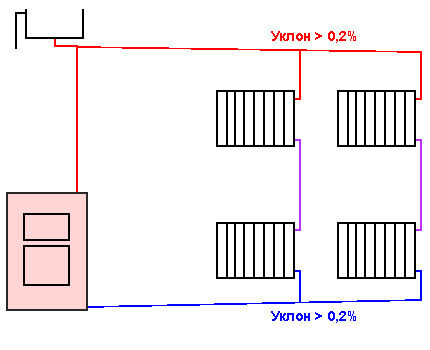
At installing heated floors a small area in a circuit with natural circulation, it is necessary to prevent air from entering the narrow and horizontally located pipes of this heating system.It is necessary to install an air removal device in front of the heated floor.
Single-pipe and two-pipe heating schemes
When developing a heating scheme for a house with natural water circulation, it is possible to design one or several separate circuits. They may differ significantly from each other. Regardless of the length, number of radiators and other parameters, they are made according to a single-pipe or two-pipe scheme.
Circuit using one line
A heating system using the same pipe for sequential supply of water to the radiators is called single-pipe. The simplest single-pipe option is heating with metal pipes without the use of radiators.
This is the cheapest and least problematic way to heat a house when choosing natural coolant circulation. The only significant disadvantage is the appearance of bulky pipes.
At the most economical single-pipe version With heating radiators, hot water flows sequentially through each device. A minimum number of pipes and shut-off valves is required here.
As you go coolant cools down, so subsequent radiators receive colder water, which must be taken into account when calculating the number of sections.
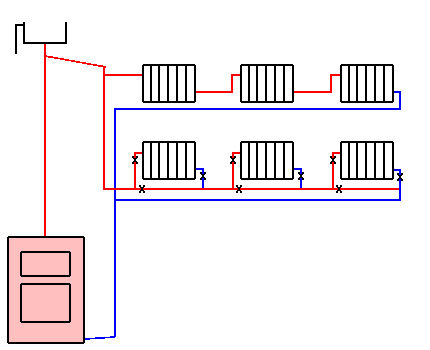
The most effective way to connect heating devices to a single-pipe network is considered to be the diagonal option.
According to this scheme of heating circuits with a natural circulation type, hot water enters the radiator from above, and after cooling it is discharged through the pipe located below.When passing in this way, heated water gives off the maximum amount of heat.
When both the inlet and outlet pipes are connected to the battery at the bottom, the heat transfer is significantly reduced, because the heated coolant has to travel the longest possible path. Due to significant cooling, batteries with a large number of sections are not used in such circuits.
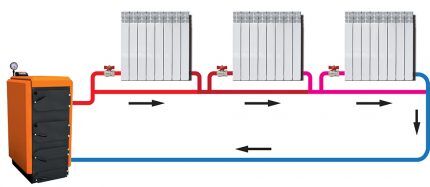
Heating circuits with similar connection of radiators are called “Leningradka". Despite the noted heat losses, they are preferred in the arrangement of residential heating systems, which is due to the more aesthetic appearance of the pipeline.
A significant disadvantage of single-pipe networks is the inability to turn off one of the heating sections without stopping the circulation of water throughout the entire circuit.
Therefore, they usually use a modernization of the classical scheme with the installation “bypass» to bypass the radiator using a branch with two ball valves or a three-way valve. This allows you to regulate the water supply to the radiator, even turning it off completely.
For two or more storey buildings, variants of a single-pipe scheme with vertical risers are used. In this case, the distribution of hot water is more uniform than with horizontal risers. In addition, vertical risers are shorter and fit better into the interior of the house.
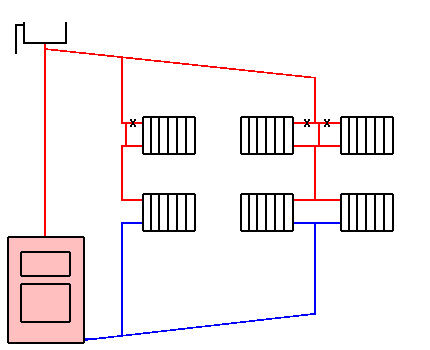
Option using a return pipe
When one pipe is used to supply hot water to radiators, and the second to drain cooled water to a boiler or furnace, this heating scheme is called a two-pipe heating system. In the presence of heating radiators, such a system is used more often than a single-pipe system.
It is more expensive, as it requires the installation of an additional pipe, but has a number of significant advantages:
- more uniform temperature distribution coolant supplied to the radiators;
- easier to calculate dependence of radiator parameters on the area of the heated room and the required temperature values;
- more efficient heat control to each radiator.
Depending on the direction of movement of chilled water relative to hot water, two-pipe systems divided into passing and dead-end. In associated circuits, the movement of cooled water occurs in the same direction as hot water, so the cycle length for the entire circuit is the same.
In dead-end circuits, cooled water moves towards hot water, so for different radiators the lengths of coolant circulation cycles differ. Since the speed in the system is low, the heating time can vary significantly. Those radiators whose water cycle cycle length is shorter will heat up faster.

There are two types of location of the liner relative to the heating radiators: upper and lower.With the top connection, the pipe supplying hot water is located above the heating radiators, and with the bottom connection, it is below.
With a bottom connection, it is possible to remove air through radiators and there is no need to run pipes from above, which is good from the point of view of room design.
However, without an acceleration manifold, the pressure drop will be much less than when using the top line. Therefore, the bottom liner is practically not used when heating premises according to the principle of natural circulation.
Conclusions and useful video on the topic
Organization of a single-pipe circuit based on an electric boiler for a small house:
Operation of a two-pipe system for a one-story wooden house based on a long-burning solid fuel boiler:
The use of natural circulation during the movement of water in the heating circuit requires accurate calculations and technically competent installation work. If these conditions are met, the heating system will efficiently heat the premises of a private house and relieve the owners from pump noise and dependence on electricity.
If you have any questions on the topic or would like to share your personal experience in organizing and operating a gravity-type heating system, please leave comments on this article. The feedback block is located below.




Heating systems with natural circulation are used, as a rule, in private houses, so which type to choose, single-pipe or with return (two-pipe), is determined by the project budget. Moreover, with a small area and a rational arrangement of rooms, it is possible to calculate the layout of the batteries in such a way that the effect of cooling the coolant in each will be insignificant.In terms of the complexity of the construction, a single-pipe system is preferable, plus it is also cheaper.
I am deciding on a heating project for my private home. I can’t decide which type is better to choose: single-pipe or double-pipe? On the one hand, the first method is less expensive. You can save a lot on materials, but on the other hand, it has its drawbacks. For example, it is impossible to regulate the heating temperature; the coolant is colder in rooms far from the boiler. For example, with a two-pipe system, if it became hot in the bedroom, they turned on the valve to reduce the temperature. And in a house with single-pipe heating, after this the other rooms will also cool down.
Hello. Nothing will cool down if you install bypasses with thermostats. IN this article describes in detail about bypasses in the heating system. However, a two-pipe heating system is still more preferable, although it is financially expensive.
Hello. Please tell me. Wood-burning stove, battery with a small heat exchanger (1.3 l), next to it is a 200 l barrel for watering the greenhouse. At what height should it be placed so that the water circulates?
I express my gratitude to the authors for an accessible presentation of technical information. Accessible to people without special technical education. Without a lot of formulas and terms.
Thank you for your competent presentation.
Thank you very much for the information. I read it for my own peace of mind, if there are any mistakes I will correct it. But, in principle, I have drawn up a scheme in my head, I hope it will work as it should.
Good afternoon.With a two-pipe system with a parallel movement of the coolant, still on the ground floor I would like to provide a lower connection to the radiators by running a supply pipe in the basement of the house. Can you tell me the specifics of the connection? What is the maximum permissible height of the radiator connection from the basement? At what point (in the basement or above) is it best to connect the lines to the riser? The boiler is located in the basement at the lowest point. And is it permissible to have non-vertical sections on a hot riser? Thank you.
Let me try to help in solving your question, as far as I can imagine visually everything that you described. For a clear example, I’ll immediately attach a general diagram that will help you navigate how future wiring will take place. In this case, with the installation of an expansion tank in the attic.
I would recommend doing it through the top connection to the radiators, it will be more practical, the diagram shows everything quite clearly. I don’t think that your basement is very high so that we can talk about any restrictions on the height of the liner.
It would be best to connect the main to the riser in the basement for a number of reasons. Firstly, such a unit will be conspicuous in the house, and even if something happens, it will be difficult to make repairs. In the basement there is a technical room where any repair work can be carried out.
It is necessary to run a pipe from the expansion tank into the return line so that it warms up, otherwise it will always be cold.